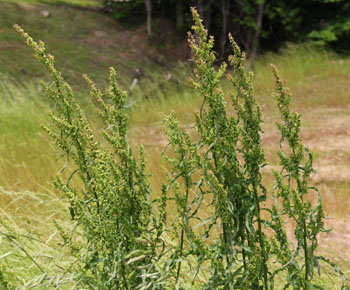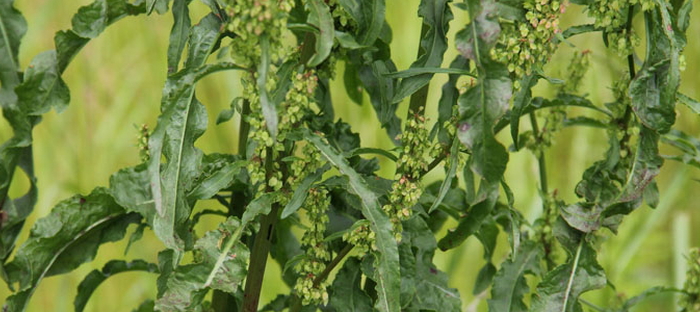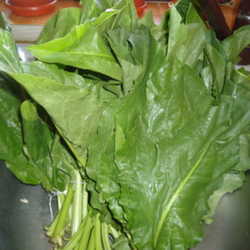Curly dock (Rumex crispus) is a common roadside and barnyard weed. It is a relative of the familiar buckwheat and in days past, was considered useful. Today, this native of southern Europe and Africa is just another unwanted plant to be banished from gardens and pastures. It is non-native to the rest of the world, however in many areas it isn't present in enough numbers to be considered a noxious pest.
This perennial is toxic to livestock and poultry, so should be eradicated from their grazing areas. The good thing is, it has no ill effects on humans, so we can make good use of it. Curly dock, yellow dock, or sour dock, as it is sometimes called, is partial to disturbed ground in sunny areas. That generally means that you'll find it growing at the edges of agricultural fields and livestock enclosures. I also see quite a bit of it growing along the un-mowed roadsides. It can spring up just about anywhere as the seeds can remain viable for 50-to 80 years and each plant can produce up to 60,000 of them.
 Early peoples ground the seeds into a type of flour (it is a relative of buckwheat, after all) and they also roasted them to prepare a coffee-like drink. Young leaves were used as a spring potherb and they are more nutritious than either spinach or carrots, high in beta-carotene, vitamin C and zinc. This was definitely a nutrition-packed plant for the malnourished winter-weary. There are several modern chefs who advocate shredding the young leaves and using them in stir-fry too. They have a pleasant, sour taste and while the older leaves can be tough and stringy, the young ones can be eaten, ribs and all.
Early peoples ground the seeds into a type of flour (it is a relative of buckwheat, after all) and they also roasted them to prepare a coffee-like drink. Young leaves were used as a spring potherb and they are more nutritious than either spinach or carrots, high in beta-carotene, vitamin C and zinc. This was definitely a nutrition-packed plant for the malnourished winter-weary. There are several modern chefs who advocate shredding the young leaves and using them in stir-fry too. They have a pleasant, sour taste and while the older leaves can be tough and stringy, the young ones can be eaten, ribs and all.
While livestock and domestic poultry shouldn't consume it, curly dock seeds are a favorite of a number of game birds and it is also a host plant for the Copper family of butterflies. The dried seeds produce a lovely, creamy yellow dye when alum is used as a mordant. The roots produce a darker olive shade. Unfortunately it is also a host and carrier of a number of agricultural diseases, so it is a double-edged sword. It gives on one hand, but takes with another.
 Some interesting legends and folklore surround this common weed. One of the weirdest was the belief that it could 'draw' love. The lovelorn were instructed to dig a root of the curly dock, dress it in a similar manner as the one they had affection for and carry this doll for a month. (now comes the weird part) After carrying this doll for a month, they were instructed to chop up the root and boil it in water. When this potion cooled, the lovelorn was to wash their entire body in it. This would 'draw' the object of their desire to them forever. The tea from the boiled roots was also rubbed on the doorknobs of businesses to 'draw' customers and people washed their coins in it to 'draw' more money to their pocketbooks.
Some interesting legends and folklore surround this common weed. One of the weirdest was the belief that it could 'draw' love. The lovelorn were instructed to dig a root of the curly dock, dress it in a similar manner as the one they had affection for and carry this doll for a month. (now comes the weird part) After carrying this doll for a month, they were instructed to chop up the root and boil it in water. When this potion cooled, the lovelorn was to wash their entire body in it. This would 'draw' the object of their desire to them forever. The tea from the boiled roots was also rubbed on the doorknobs of businesses to 'draw' customers and people washed their coins in it to 'draw' more money to their pocketbooks.
It is amazing what interesting tidbits surround these forgotten plants. Some are based in fact and others are pure fantasy, but as a lover of trivia I find the search fascinating.


















